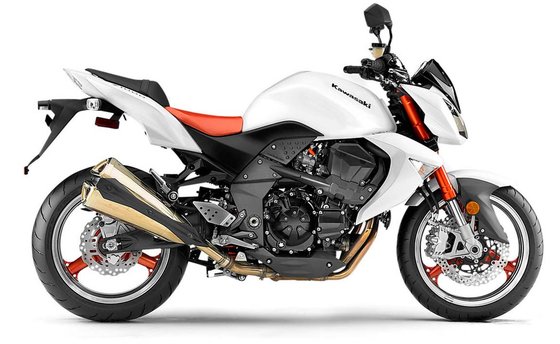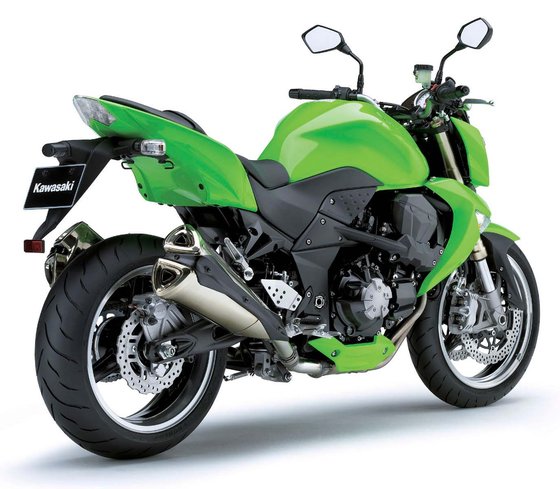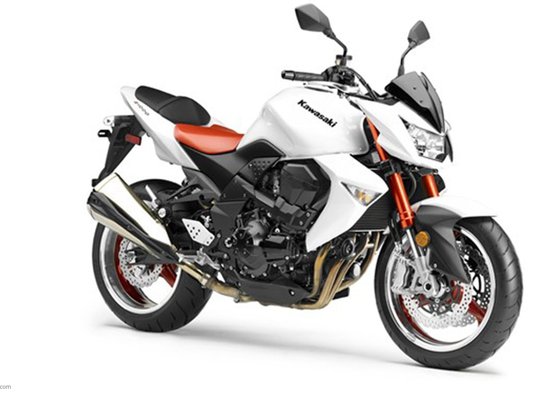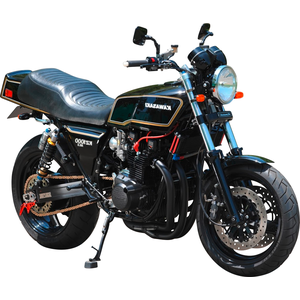Kawasaki Z 1000 (2007-2009) Review: The Raw Essence of Streetfighter Thrills

Introduction
The Kawasaki Z 1000 (2007-2009) isn’t just a motorcycle—it’s a declaration of rebellion. Designed to dominate the naked bike segment with unapologetic aggression, this generation of the Z 1000 combines superbike DNA with streetfighter practicality. From its snarling 953cc inline-four engine to its razor-sharp chassis, every element screams "fun first." Having spent time with this machine, it’s clear Kawasaki engineered it for riders who crave visceral feedback and adrenaline without the fuss of fairings. Let’s dissect what makes this generation a cult favorite.
Design & Ergonomics: Brutal Beauty Meets Functional Comfort

The Z 1000’s design is a masterclass in muscular minimalism. The exposed steel backbone frame, angular fuel tank, and twin underseat mufflers give it a predatory stance. Kawasaki’s signature "Sugomi" design language isn’t just for show—it centralizes mass for agility, with the engine positioned low to enhance stability.
The riding position strikes a rare balance between sporty aggression and daily usability. The 820mm (32.3-inch) seat height accommodates most riders, while the slightly rear-set pegs and wide, flat handlebars create a commanding posture. During my test ride, the slim saddle and narrow midsection made it easy to grip the tank during hard cornering, though the seat foam could use more cushion for multi-hour rides.
Color options like Pearl Crystal White and Metallic Diablo Black emphasize its minimalist aesthetic, though aftermarket vinyl wraps or custom paint jobs (available at MOTOPARTS.store) can amplify its visual punch.
Engine & Performance: A Torque Monster With Superbike Roots

At the heart of the Z 1000 lies a 953cc liquid-cooled inline-four, derived from the legendary Ninja ZX-9R. With 127 HP (92.7 kW) at 10,000 RPM and 95.6–99.1 Nm (70.5–73.1 lb-ft) of torque peaking at 8,200 RPM, this engine prioritizes mid-range punch over top-end frenzy. Throttle response is immediate, with a linear powerband that pulls hard from 4,000 RPM onward.
Key highlights:
- Fuel Injection: Keihin 36mm throttle bodies deliver crisp fueling, eliminating the lag often seen in early 2000s fuel-injected bikes.
- Gearbox: The 6-speed transmission shifts with mechanical precision, though the cable-operated clutch requires a firm pull in traffic.
- Exhaust Note: The stock mufflers produce a deep, bass-heavy growl, but swapping to an aftermarket slip-on (like options from MOTOPARTS.store) unleashes a spine-tingling howl.
Acceleration is relentless—0–100 km/h (0–62 mph) takes 3.2 seconds, and the quarter-mile flashes by in 11.3 seconds at 196 km/h (122 mph). Despite a top speed of 238 km/h (148 mph), the Z 1000 feels most at home carving canyon roads rather than chasing lap times.
Handling & Dynamics: Precision Meets Playfulness
Kawasaki’s chassis engineers nailed the balance between rigidity and flex. The high-tensile steel frame and aluminum subframe provide telepathic feedback, letting you sense every ripple in the asphalt. Paired with a 41mm inverted fork (rebound and preload adjustable) and a Bottom-Link Uni-Trak rear shock, the Z 1000 dances through corners with the agility of a lighter machine.
Key handling specs:
- Wheelbase: 1,420–1,455mm (55.9–57.3 inches)
- Rake/Trail: 24.5–25° / 102–103mm (4.0–4.1 inches)
- Tires: 120/70-ZR17 front, 190/50-ZR17 rear
Braking performance is equally impressive. Dual 300mm petal discs with 4-piston calipers up front offer progressive bite, while the single 250mm rear disc provides ample stopping power. For track enthusiasts, upgrading to sintered pads (available in our store) reduces fade during aggressive riding.
Competition: How the Z 1000 Stacks Up
The Z 1000’s prime rivals in the 2000s naked bike wars included:
- Suzuki GSX-S1000 (2005-2009): Lighter and slightly more powerful, but lacks the Z 1000’s low-end grunt and streetfighter charisma.
- Yamaha FZ1 (2006-2015): Softer suspension and upright ergos make it a better tourer, but less engaging on twisty roads.
- Honda CB1000R (2008-2016): Sleeker design and smoother engine, yet Honda’s refinement comes at the cost of raw excitement.
Where the Z 1000 shines is its torque-centric tuning and aggressive ergonomics, making it ideal for riders who value thrill over practicality. Compared to European rivals like the Aprilia Tuono 1000R, the Kawasaki offers lower maintenance costs and easier part availability—a perk for DIY enthusiasts shopping at MOTOPARTS.store.
Maintenance: Keeping the Beast Alive
The Z 1000 is robust but demands attentive care:
- Oil Changes: Use SAE 10W-40 (3.3L with filter). Synthetic blends reduce wear during high-RPM runs.
- Valve Adjustments: Check every 26,000 km (16,000 miles). Clearances:
- Intake: 0.15–0.24mm (0.006–0.009 in)
- Exhaust: 0.22–0.31mm (0.009–0.012 in)
- Cooling System: Replace coolant every 2 years (2.9L capacity).
- Chain Care: The 110-link chain and 15/40 sprocket combo requires regular lubrication. A DID chain kit from our store ensures longevity.
- Tire Pressures: 2.5 bar (36 psi) front / 2.9 bar (42 psi) rear for optimal grip.
Common upgrades include:
- High-performance air filters
- Adjustable levers for better ergonomics
- LED lighting kits for improved visibility
Conclusion: A Timeless Streetfighter Icon
The 2007–2009 Kawasaki Z 1000 remains a benchmark for raw, unfiltered motorcycling. It’s not the most refined or technologically advanced bike of its era, but its combination of brutal power, razor-sharp handling, and head-turning design creates an addictive riding experience. Whether you’re blasting through city streets or attacking backroads, the Z 1000 delivers grins per mile that few contemporaries can match.
For owners looking to enhance their ride, MOTOPARTS.store offers everything from premium exhausts to suspension upgrades—because even legends can use a modern touch.
Specifications sheet
| Engine | |
|---|---|
| Stroke: | Four-stroke |
| Max power: | 93 kW | 125.0 hp |
| Max torque: | 96 Nm |
| Fuel system: | Fuel Injection (Keihin 36mm throttle bodies x4) |
| Max power @: | 10000 rpm |
| Displacement: | 953 ccm |
| Max torque @: | 8000 rpm |
| Bore x stroke: | 77.2 x 50.9 mm (3.0 x 2.0 in) |
| Configuration: | Inline |
| Cooling system: | Liquid |
| Compression ratio: | 11.2:1 |
| Number of cylinders: | 4 |
| Valves per cylinder: | 4 |
| Dimensions | |
|---|---|
| Wheelbase: | 1445 mm (56.9 in) |
| Dry weight: | 198 |
| Wet weight: | 221 |
| Seat height: | 820 mm (32.3 in) |
| Overall width: | 780 mm (30.7 in) |
| Overall height: | 1065 mm (41.9 in) |
| Overall length: | 2090 mm (82.3 in) |
| Ground clearance: | 145 mm (5.7 in) |
| Fuel tank capacity: | 18.5 L (4.9 US gal) |
| Drivetrain | |
|---|---|
| Final drive: | chain |
| Chain length: | 110 |
| Transmission: | 6-speed, cable-operated wet clutch |
| Rear sprocket: | 40 |
| Front sprocket: | 15 |
| Maintenance | |
|---|---|
| Engine oil: | 10W40 |
| Brake fluid: | DOT 4 |
| Spark plugs: | NGK CR9EK |
| Spark plug gap: | 0.9 |
| Coolant capacity: | 2.9 |
| Forks oil capacity: | 0.73 |
| Rear tire pressure: | 2.9 bar (42 psi) |
| Engine oil capacity: | 3.3 |
| Front tire pressure: | 2.5 bar (36 psi) |
| Chain lubrication interval: | Every 500 km or after wet rides |
| Engine oil change interval: | Every 5000 km or 2 years |
| Valve clearance (intake, cold): | 0.15–0.24 mm |
| Valve clearance check interval: | 24,000 km / 15,000 mi |
| Valve clearance (exhaust, cold): | 0.22–0.31 mm |
| Performance | |
|---|---|
| Top speed: | 238 km/h (148 mph) |
| Fuel consumption (average): | 18.9 km/L (44.5 mpg) |
| Chassis and Suspension | |
|---|---|
| Rake: | 24.5° |
| Frame: | Steel backbone frame with aluminum engine sub-frame |
| Trail: | 102 mm (4.0 in) |
| Rear tire: | 190/50-z-17 |
| Front tire: | 120/70-z-17 |
| Rear brakes: | Single 250 mm petal disc with 2-piston caliper (ABS on some models) |
| Front brakes: | Dual 300 mm petal discs with 4-piston calipers (ABS on some models) |
| Rear suspension: | Uni-Trak linkage system, adjustable rebound damping and spring preload / 150 mm (5.9 in) travel |
| Front suspension: | 41mm inverted cartridge fork, adjustable rebound damping and spring preload / 160 mm (6.3 in) travel |



















